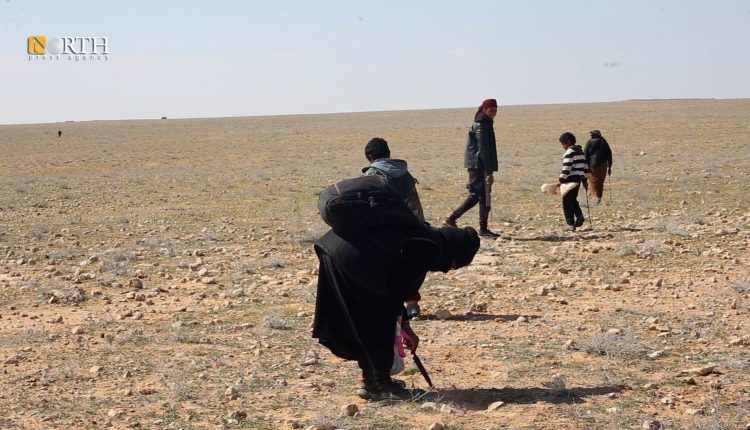
By Ali al-Beki’
DEIR EZ-ZOR, Syria (North Press) – In the barren lands of Kabajeb, in Syria’s eastern countryside of Deir ez-Zor, residents set out daily in search of desert truffles—often called the “gold of the desert.” But their pursuit of this precious delicacy is fraught with peril, as landmines left behind by war lurk beneath the sand, ready to claim more lives.
Despite the ever-present danger, many have no choice but to continue. The truffles provide a rare source of income in the midst of extreme economic hardship, making the risks an unfortunate necessity for survival.
A land scattered with death
Samer al-Deiri, a resident of Kabajeb, describes the grim reality: “Every day, people go out looking for truffles, hoping to find a kilo or even less. But almost every day, we lose someone to the mines.”
Some of these deadly traps remain hidden underground, invisible until an unsuspecting forager steps on one. “The entire area is surrounded by landmines. Still, people keep searching for a livelihood, knowing the risks they face,” he added.
The community has repeatedly called on demining teams to clear the region, as the number of casualties—many of them women and children—continues to rise.
In late January 2025, three civilians were killed and two others injured when a landmine exploded under their vehicle in the south of Deir ez-Zor.
According to the Syrian Civil Defense (White Helmets), between Nov. 27, 2024, and Jan. 22, 2025, at least 43 civilians, including eight children and a woman, lost their lives in mine-related incidents across Syria, with 72 others injured—some critically.
Landmines are not the only hazard. The vast Syrian desert remains a stronghold for ISIS sleeper cells, which continue to launch deadly attacks on those venturing into the wilderness.
On March 6, 2024, 18 people—both civilians and military personnel—were killed in an ISIS ambush in Kabajeb’s desert while collecting truffles. The incident underscored the dual threats faced by foragers: hidden explosives beneath their feet and armed extremists lurking in the shadows.
Desperation pushes people to risk their lives
Maher al-Hamad, a truffle hunter, narrates his daily ordeal: “We start at dawn, hoping to gather half a kilo, maybe a full kilo if we’re lucky. Some days, we find nothing at all.”
Despite knowing that mines are scattered near abandoned military outposts, foragers press on, driven by poverty. “Our daily earnings range from 100,000 to 150,000 Syrian pounds, sometimes not even enough to cover transportation costs,” Maher explains.
Over time, local truffle hunters have managed to uncover and destroy around 500 landmines, yet countless more remain hidden, turning each outing into a game of survival.
Tragedy struck again last November when two brothers, Alaa, 30, and Ali al-Jamal, 32, were killed after their vehicle hit a landmine while traveling the Deir ez-Zor–Damascus highway.
A bleak truffle season amid drought
In addition to security concerns, poor rainfall has significantly reduced this year’s truffle yield. Nasser al-Hamdoosh, a local truffle trader, notes, “This season’s production is far lower than previous years, which has caused prices to soar.”
Truffle prices now range from 200,000 to 300,000 Syrian pounds per kilogram, depending on the type. The prized Zubaidi truffle, known for its high quality, can fetch up to 250,000 Syrian pounds per kilo, while the less expensive red truffle is mostly sold in local markets.
The harvest has also dwindled dramatically. “In past years, daily yields reached 40 to 60 tons. This year, it’s barely one to two tons,” al-Hamdoosh explains. The reason? Lack of rain.
“If we get rain next week, the season might improve. Otherwise, it will end prematurely,” he adds.
As traders wait for rain to revive the truffle season, the people of Kabajeb wait for a different kind of relief—one that will rid their land of death traps so they can earn a living without the constant fear of being the next victim.
